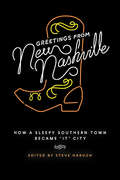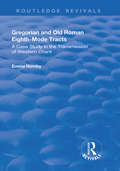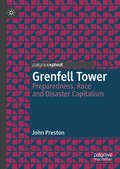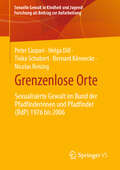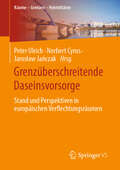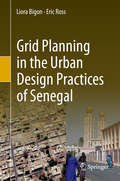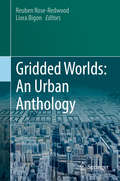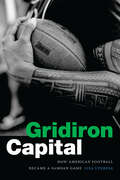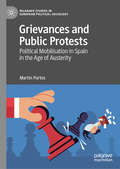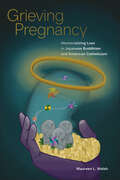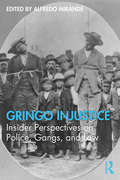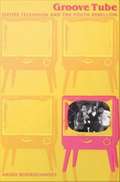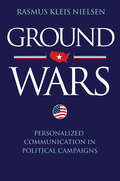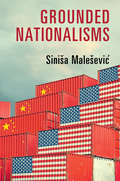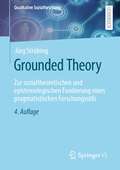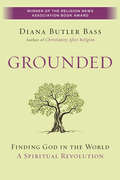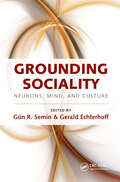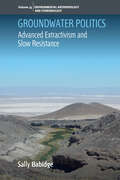- Table View
- List View
Greentopia: Towards a Sustainable Toronto (uTOpia)
by Jonny Dovercourt Alana WilcoxGardening the Gardiner. Hydrogen-fuelled cabs. Rooftop Power. Rainwater harvesting. A new model of taxation. The art of salvage. Drinking less coffee. Composters for dog poo in city parks. Ravine City.What would make Toronto a greener place?This third book in the uTOpia series asked imaginative Torontonians to think both big and small about how we might make our city more environmentally wise and responsible. They responded with immodest proposals and how-to tips, thoughtful considerations and flights of fancy that just might work. They wrote essays long and short, taking stock of how far weve come in the struggle to green ourselves and providing suggestions for simple actions with big effects. Their ideas sometimes playful, sometimes pie-in-the-sky offer brazen new perspectives on transportation, garbage, trees, energy, water, animals and green space and arrive at imaginative and ingenious solutions to the problems plaguing all modern cities.GreenTOpia features a resources section, including profiles of key eco-friendly groups in the GTA, a directory of green organizations, as well as a how-to guide and a fun-facts section.
Greetings from New Nashville: How a Sleepy Southern Town Became "It" City
by Steve HaruchIn 1998, roughly 2 million visitors came to see what there was to see in Nashville. By 2018, that number had ballooned to 15.2 million. In that span of two decades, the boundaries of Nashville did not change. But something did. Or rather, many somethings changed, and kept changing, until many who lived in Nashville began to feel they no longer recognized their own city. And some began to feel it wasn't their own city at all anymore as they were pushed to its fringes by rising housing costs. Between 1998 and 2018, the population of Nashville grew by 150,000. On some level, Nashville has always packaged itself for consumption, but something clicked and suddenly everyone wanted a taste. But why Nashville? Why now? What made all this change possible? This book is an attempt to understand those transformations, or, if not to understand them, exactly, then to at least grapple with the question: What happened?
Gregorian and Old Roman Eighth-mode Tracts: A Case Study in the Transmission of Western Chant (Routledge Revivals)
by Emma HornbyThis title was first published in 2002: This text uses detailed analysis of the eigth-mode tracts in addressing some of the still unresolved questions of chant scholarship. The first question is that of the nature of the relationship between Old Roman and Gregorian chant, the second, of the relationship between oral and written modes of transmission in the ecclesiastical culture of the Middle Ages. Also, the Middle Ages saw a transition to a culture more dependent on writing. The book investigates the effect this transition had on the way eighth-mode tracts were understood by those who performed and notated them.
Grenfell Tower: Preparedness, Race and Disaster Capitalism
by John PrestonThe Grenfell Tower fire of June 2017 is one of the most tragic political events in British history. This book argues that preparedness for disasters has always been designed in the interests of the State and Capital rather than citizens. This was exemplified by the ‘stay put’ strategy at Grenfell Tower which has historically been used to socially control racialised working class groups in a disaster. ‘Stay put’, where fire safety is compromised along with strategic ambiguity, probabilistically eliminates these groups. Grenfell Tower is a purposive part of ‘Disaster Capitalism’, an asocial racial and class eliminationism, where populations have become unvalorisable and disposable. We have reached a point where even the ruling class are fleeing from the disasters and chaos they have inflicted on the world, retreating to their billionaire bunkers. This timely book will be of interest to sociologists, social theorists and activists in understanding the racialised, classed and capitalist nature of contemporary disasters.
Grenzenlose Orte: Sexualisierte Gewalt im Bund der Pfadfinderinnen und Pfadfinder (BdP) 1976 bis 2006 (Sexuelle Gewalt in Kindheit und Jugend: Forschung als Beitrag zur Aufarbeitung)
by Bernard Könnecke Peter Caspari Helga Dill Tinka Schubert Nicolas ReisingMit diesem Band liegt die erste wissenschaftliche Studie zur Aufarbeitung sexualisierter Gewalt in einem Jugendverband im deutschsprachigen Raum vor. Auf der Basis qualitativer Interviews und Dokumentenrecherchen werden Ausmaß und Erscheinungsformen sexualisierter Gewalt im Bund der Pfadfinderinnen und Pfadfinder von 1976 – 2006 dargestellt. Aus einer sozialpsychologischen Perspektive werden die hohe subjektive Bedeutung und die enge Bindung von Kindern und Jugendlichen zu ihrer jeweiligen Pfadfindergruppe erklärt. Sexualisierte Gewalt erweist sich in diesem Kontext als Phänomen, das auf tradierten Hierarchien, informellen Machtasymmetrien und emotionalen Abhängigkeiten beruht. Junge Pfadfinderinnen und Pfadfinder waren mit dem Umgang mit entsprechenden (Verdachts-)fällen überfordert. Geblendet von eigenen Machbarkeitsvorstellungen ignorierten sie Betroffene und scheiterten mit ihren Versuchen, Täter nachhaltig unter Kontrolle zu bringen. Aus den in dieser Studie gewonnen Erkenntnissen werden Empfehlungen für Aufarbeitung und Prävention abgeleitet, die auch in anderen Jugendverbänden Anwendung finden können.
Grenzüberschreitende Daseinsvorsorge: Stand und Perspektiven in europäischen Verflechtungsräumen (Räume – Grenzen – Hybriditäten)
by Peter Ulrich Norbert Cyrus Jarosław JańczakGrenzüberschreitende Verbindungen werden in der Europäischen Union dichter und intensiver. Die national organisierten und ausgerichteten Angebote der öffentlichen Daseinsvorsorge kommen an ihre Grenzen. Der Band führt in das innovative Konzept der grenzüberschreitenden Daseinsvorsorge ein und bietet eine theoretisch fundierte Grundlage für die Analyse von Stand und Entwicklungsperspektiven grenzüberschreitender Angebote der Daseinsvorsorge. Das Buch versammelt Beiträge mit konzeptionellen Überlegungen sowie empirischen Analysen der Praxis grenzüberschreitender Kooperationen in den Daseinsvorsorgebereichen Mobilität, Gesundheit, Bildung, Katastrophenschutz, Energiekooperation, Wärmeversorgung, Raumplanung und Grenzmobilitätsberatung. Die transdisziplinäre Ausrichtung des Bandes befördert den intra- und interregionalen Dialog zur Gestaltung grenzüberschreitender Daseinsvorsorge und bietet Impulse für Lern- und Transferprozesse in und zwischen europäischen Verflechtungsräumen.
Grenzüberschreitungen im Kompetenzmanagement: Trends und Entwicklungsperspektiven (Kompetenzmanagement in Organisationen)
by Inga Truschkat Ralf Knackstedt Kristin Kutzner Miriam SitterDas Fachbuch zeigt Innovationspotenziale im Kompetenzmanagement auf. Diese Potenziale unterstützen Organisationen beispielsweise bei der Gewinnung und Bindung von Fachkräften, bei der Realisierung komplexer Leistungsangebote und bei der Erhöhung von Effizienz und Effektivität betrieblicher Abläufe. Sie erhalten konkrete Hinweise und anregende Perspektiven zur Innovation des Kompetenzmanagements und Ihnen werden Chancen und Risiken von Grenzüberschreitungen aufgezeigt. Als Leitmotiv dient dabei die Zusammenführung von bisher traditionell unzureichend verbundenen und oft isoliert betrachteten Aspekten des Kompetenzmanagements.
Grid Planning in the Urban Design Practices of Senegal
by Liora Bigon Eric RossThis book is the first to trace the genealogy of an indigenous grid-pattern settlement design practice in Africa, and more specifically in Senegal. It does so by analyzing how the precolonial grid-plan design tradition of this country has become entangled with French colonial urban grid-planning, and with present-day, hybrid, planning cultures. By thus, it transcends the classic precolonial-colonial-postcolonial metahistorical divides.This properly illustrated book consists of five chapters, including an introductory chapter (historiography, theory and context) and a concluding chapter. The chapters’ text has both a chronological and thematic rationale, aimed at enhancing Islamic Studies by situating sub-Saharan Africa’s urbanism within mainstream research on the Muslim World; and at contributing directly to the wider project of de-Eurocentrizing urban planning history by developing a more inclusive, truly global, urban history.
Gridded Worlds: An Urban Anthology
by Liora Bigon Reuben Rose-RedwoodThis book is the first edited collection to bring together classic and contemporary writings on the urban grid in a single volume. The contributions showcased in this book examine the spatial histories of the grid from multiple perspectives in a variety of urban contexts. They explore the grid as both an indigenous urban form and a colonial imposition, a symbol of Confucian ideals and a spatial manifestation of the Protestant ethic, a replicable model for real estate speculation within capitalist societies and a spatial framework for the design of socialist cities. By examining the entangled histories of the grid, Gridded Worlds considers the variegated associations of gridded urban space with different political ideologies, economic systems, and cosmological orientations in comparative historical perspective. In doing so, this interdisciplinary anthology seeks to inspire new avenues of research on the past, present, and future of the gridded worlds of urban life. Gridded Worlds is primarily tailored to scholars working in the fields of urban history, world history, urban historical geography, architectural history, urban design, and the history of urban planning, and it will also be of interest to art historians, area studies scholars, and the urban studies community more generally.
Gridiron Capital: How American Football Became a Samoan Game
by Lisa UperesaSince the 1970s, a “Polynesian Pipeline” has brought football players from American Sāmoa to Hawaii and the mainland United States to play at the collegiate and professional levels. In Gridiron Capital Lisa Uperesa charts the cultural and social dynamics that have made football so central to Samoan communities. For Samoan athletes, football is not just an opportunity for upward mobility; it is a way to contribute to, support, and represent their family, village, and nation. Drawing on ethnographic fieldwork, archival research, and media analysis, Uperesa shows how the Samoan ascendancy in football is underpinned by the legacies of US empire and a set of imperial formations that mark Indigenous Pacific peoples as racialized subjects of US economic aid and development. Samoan players succeed by becoming entrepreneurs: building and commodifying their bodies and brands to enhance their football stock and market value. Uperesa offers insights into the social and physical costs of pursuing a football career, the structures that compel Pacific Islander youth toward athletic labor, and the possibilities for safeguarding their health and wellbeing in the future.Duke University Press Scholars of Color First Book Award recipient
Grief: The Price of Love
by Svend BrinkmannWherever love and death meet there is grief. It affects us all regardless of ethnicity, age, class, or sexual orientation. Grief is universal – it has endured across time, societies and cultures from the earliest human communities to the present day. But the way we deal with grief is changing. Increasingly, we are diagnosing grief as a medical condition to be treated rather than embracing it as a natural part of being human. In this book, Svend Brinkmann gets to the heart of what it is to grieve, arguing that the sorrow we experience after the death of a loved one is a necessary and meaningful dimension of human existence. However painful, it unites us all. As humans we are uniquely privileged to feel grief. Rather than trying to escape or smother grief, we must allow ourselves to feel and accept it as the price we pay for love.
Grievances and Public Protests: Political Mobilisation in Spain in the Age of Austerity (Palgrave Studies in European Political Sociology)
by Martín PortosThis book sheds light on the role that grievances play for mobilisation dynamics in a context of material deprivation. Why do people protest? To what extent do grievances account for the varying size of protest events over time? Covering different levels of analysis, the author argues that effects of socioeconomic aspects (both objective-material deprivation and subjective-attitudinal grievances) are mediated by political attitudes, especially political dissatisfaction. He develops a framework to account for the dynamics, trajectory and timing of the cycle of contention that unfolded in Spain in the shadow of the Great Recession, contributing not only to the field of social movement studies but to our broader understanding of European politics, political sociology, political economy and economic sociology.
Grieving Pregnancy: Memorializing Loss in Japanese Buddhism and American Catholicism
by Maureen L. WalshIn Grieving Pregnancy: Memorializing Loss in Japanese Buddhism and American Catholicism, Maureen L. Walsh compares how the two religious traditions respond ritually and discursively to miscarriage, stillbirth, and abortion experiences marked by grief for the women involved. The experience of pregnancy loss has always been a part of women’s lives, yet only recently has it garnered attention from religious leaders and scholars commensurate with its prevalence. This book examines pregnancy loss as a theological problem for both Buddhism and Catholicism and analyzes the rites and memorials that have developed to address it, such as Japanese Buddhist mizuko kuyō (water children rites) and emergent American Catholic memorial practices focused on pregnancy loss. These parallel practices have emerged within distinct religious landscapes—a fact reflected in their forms and purposes—and when considered together, they raise questions of keen interest to theological and religious studies about the goals of religious practice and the imagination of human life at its earliest stages.
Gringo Injustice: Insider Perspectives on Police, Gangs, and Law
by Alfredo MirandéThe recent mass shooting of 22 innocent people in El Paso by a lone White gunman looking to "Kill Mexicans" is not new. It is part of a long, bloody history of anti-Latina/o violence in the United States. Gringo Injustice brings this history to life, shedding critical light on the complex relationship between Latinas/os and the United States’ legal and judicial system. Contributors with first-hand knowledge and experience, including former law enforcement officers, ex-gang members, attorneys, and community activists, share insider perspectives on the issues facing Latinas/os and initiate a critical dialogue on this neglected topic. Essays examine the unauthorized use of deadly force by police and patterned incidents of lynching, hate crimes, gang violence, and racial profiling. The book also highlights the hyper-criminalization of barrio youth and considers wide-ranging implications from the disproportionate imprisonment of Latinas/os. Gringo Injustice provides a comprehensive and powerful look into the Latina/o community’s fraught history with law enforcement and the American judicial system. It is an essential reference for students and scholars interested in intersections between crime and communities of Color, and for use in Sociology, Latino Studies, Ethnic Studies, Chicano Studies, Criminology, and Criminal Justice.
Grocery Story: The Promise Of Food Co-ops In The Age Of Grocery Giants
by Jon SteinmanHungry for change? Put the power of food co-ops on your plate and grow your local food economy. <p><p> Food has become ground-zero in our efforts to increase awareness of how our choices impact the world. Yet while we have begun to transform our communities and dinner plates, the most authoritative strand of the food web has received surprisingly little attention: the grocery store—the epicenter of our food-gathering ritual. <p> Through penetrating analysis and inspiring stories and examples of American and Canadian food co-ops, Grocery Story makes a compelling case for the transformation of the grocery store aisles as the emerging frontier in the local and good food movements. Author Jon Steinman: <p> Deconstructs the food retail sector and the shadows cast by corporate giants Makes the case for food co-ops as an alternative Shows how co-ops spur the creation of local food-based economies and enhance low-income food access. <p> Grocery Story is for everyone who eats. Whether you strive to eat more local and sustainable food, or are in support of community economic development, Grocery Story will leave you hungry to join the food co-op movement in your own community.
Groepsdynamiek en Teambuilding: Een handboek
by Hiriyappa BDit boek grijpt je naar de keel en gidst je naar het succes. Heb je je ooit afgevraagd hoe je een succesvolle professional kunt worden? Dit boek grijpt je naar de keel en brengt je naar het succes. Het bevestigt het beeld dat een team altijd slimmer is dan een individu. De methodiek in dit boek wordt gevolgd in simpel te volgen stappen zodat u altijd aan dit boek kunt refereren. Om het lezen makkelijker te maken worden de ideeen gepresenteerd door middel van opsommingen. Ik hoop dat je een succesvolle carriere zult hebben.
Groove Tube: Sixties Television and the Youth Rebellion
by Aniko BodroghkozyCritics often claim that prime-time television seemed immune--or even willfully blind--to the landmark upheavals rocking American society during the 1960s. Groove Tube is Aniko Bodroghkozy's rebuttal of this claim. Filled with entertaining and enlightening discussions of popular shows of the time--such as The Monkees, The Smothers Brothers Comedy Hour, The Mod Squad--this book challenges the assumption that TV programming failed to consider or engage with the decade's youth-lead societal changes. Bodroghkozy argues that, in order to woo an increasingly lucrative baby boomer audience, television had to appeal to the social and political values of a generation of young people who were enmeshed in the hippie counterculture, the antiwar movement, campus protests, urban guerilla action--in general, a culture of rebellion. She takes a close look at the compromises and negotiations that were involved in determining TV content, as well as the ideological difficulties producers and networks faced in attempting to appeal to a youthful cohort so disaffected from dominant institutions. While programs that featured narratives about hippies, draft resisters, or revolutionaries are examined under this lens, Groove Tube doesn't stop there: it also examines how the nation's rebellious youth responded to these representations. Bodroghkozy explains how, as members of the first "TV generation," some made sense of their societal disaffection in part through their childhood experience with this powerful new medium. Groove Tube will interest sociologists, American historians, students and scholars of television and media studies, and others who want to know more about the 1960s.
Ground Control: A Design History of Technical Lands and NASA’s Space Complex
by Jeffrey S. NesbitGround Control: A Design History of Technical Lands and NASA’s Space Complex explores the infrastructural history of the United States rocket launch complex. Working primarily between 1950, the year of the first rocket launch at Cape Canaveral, to 1969, the Apollo moon landing, the book highlights the evolution of its overlooked architecture and infrastructural landscape in parallel to US aerospace history. The cases outlined in this book survey the varying architectural histories and aesthetic motivations that helped produce America’s public image of early space exploration. The built environment of the U.S. space complex shows how its expanded infrastructural landscape tended to align with national Cold War politics and themes found in the age of modernity. Examples across often inaccessible sites of remote landscape help explain the contingent histories and deep association of an American aesthetic, land-use, and ultimately a form of nation-building practices. Ground Control offers a new way of understanding how technological uses of place-based science were designed and constructed in support of both industrial and military activities in postwar America. This book will be of interest to researchers, scholars, students, and anyone with a general interest in the history of American infrastructure, land use, and space exploration.
Ground Wars: Personalized Communication in Political Campaigns
by Rasmus Kleis NielsenPolitical campaigns today are won or lost in the so-called ground war--the strategic deployment of teams of staffers, volunteers, and paid part-timers who work the phones and canvass block by block, house by house, voter by voter. Ground Wars provides an in-depth ethnographic portrait of two such campaigns, New Jersey Democrat Linda Stender's and that of Democratic Congressman Jim Himes of Connecticut, who both ran for Congress in 2008. Rasmus Kleis Nielsen examines how American political operatives use "personalized political communication" to engage with the electorate, and weighs the implications of ground war tactics for how we understand political campaigns and what it means to participate in them. He shows how ground wars are waged using resources well beyond those of a given candidate and their staff. These include allied interest groups and civic associations, party-provided technical infrastructures that utilize large databases with detailed individual-level information for targeting voters, and armies of dedicated volunteers and paid part-timers. Nielsen challenges the notion that political communication in America must be tightly scripted, controlled, and conducted by a select coterie of professionals. Yet he also quashes the romantic idea that canvassing is a purer form of grassroots politics. In today's political ground wars, Nielsen demonstrates, even the most ordinary-seeming volunteer knocking at your door is backed up by high-tech targeting technologies and party expertise. Ground Wars reveals how personalized political communication is profoundly influencing electoral outcomes and transforming American democracy.
Grounded Nationalisms: A Sociological Analysis
by Siniša MaleševićGlobalisation is not the enemy of nationalism; instead, as this book shows, the two forces have developed together through modern history. <P><P>Malešević challenges dominant views which see nationalism as a declining social force. He explains why the recent escalations of populist nationalism throughout the world do not represent a social anomaly but are, in fact, a historical norm. <P><P>By focusing on ever-increasing organisational capacity, greater ideological penetration and networks of micro-solidarity, Malešević shows how and why nationalism has become deeply grounded in the everyday life of modern human beings. <P><P>The author explores the social dynamics of these grounded nationalisms via an analysis of varied contexts, from Ireland to the Balkans. His findings show that increased ideological diffusion and the rising coercive capacities of states and other organisations have enabled nationalism to expand and establish itself as the dominant operative ideology of modernity.
Grounded Theory: Zur sozialtheoretischen und epistemologischen Fundierung eines pragmatistischen Forschungsstils (Qualitative Sozialforschung)
by Jörg StrübingWenig wurde bislang über die erkenntnistheoretische Fundierung der Grounded Theory in der pragmatischen Sozialphilosophie und die daraus resultierenden Konsequenzen für das Verständnis der methodologischen Konzeption wie der praktischen Verfahren geschrieben. Der Band schließt diese Lücke, indem das Erkenntnismodell, ausgehend von den Arbeiten von C.S. Peirce, J. Dewey, G.H. Mead und W. James, vorgestellt und den Spuren nachgegangen wird, die dieses Modell als Geltungsbegründung in der Methodologie der Grounded Theory hinterlassen hat. Dabei geht der Text auch auf die gravierenden methodologischen Unterschiede zwischen der von Anselm L. Strauss geprägten und der von Barney G. Glaser vertretenen Variante von Grounded Theory ein und beschäftigt sich mit wesentlichen Weiterentwicklungen einer pragmatistischen Grounded Theory im Kontext postmodernen Denkens. Die vorliegende, vierte Auflage schließt zudem den aktuellen Diskurs um die Etablierung ansatzübergreifender Gütekriterien qualitativen Forschens an die Grounded Theory-immanenten Strategien zur Qualitätssicherung an. Forschende erhalten damit eine wertvolle Argumentationshilfe für die Legitimation ihrer empirischen Designs.
Grounded: Finding God in the World-A Spiritual Revolution
by Diana Butler BassThe headlines are clear: religion is on the decline in America as many people leave behind traditional religious practices. Diana Butler Bass, leading commentator on religion, politics, and culture, follows up her acclaimed book Christianity After Religion by arguing that what appears to be a decline actually signals a major transformation in how people understand and experience God. The distant God of conventional religion has given way to a more intimate sense of the sacred that is with us in the world. This shift, from a vertical understanding of God to a God found on the horizons of nature and human community, is at the heart of a spiritual revolution that surrounds us - and that is challenging not only religious institutions but political and social ones as well.Grounded explores this cultural turn as Bass unpacks how people are finding new spiritual ground by discovering and embracing God everywhere in the world around us--in the soil, the water, the sky, in our homes and neighborhoods, and in the global commons. Faith is no longer a matter of mountaintop experience or institutional practice; instead, people are connecting with God through the environment in which we live. Grounded guides readers through our contemporary spiritual habitat as it points out and pays attention to the ways in which people experience a God who animates creation and community.Bass brings her understanding of the latest research and studies and her deep knowledge of history and theology to Grounded. She cites news, trends, data, and pop culture, weaves in spiritual texts and ancient traditions, and pulls it all together through stories of her own and others' spiritual journeys. Grounded observes and reports a radical change in the way many people understand God and how they practice faith. In doing so, Bass invites readers to join this emerging spiritual revolution, find a revitalized expression of faith, and change the world.
Grounding Sociality: Neurons, Mind, and Culture
by Gün R. SeminThis volume concerns the longstanding intellectual puzzle of how individuals overcome their biological, neural, and mental finitude to achieve sociality. It explores how humans take each other into account, coordinate their actions, and are able to share their inner states and to communicate. Sophisticated views on the bases of sociality are detailed at the level of neural mechanisms, perception and memory, motivation, communication and dialog, culture, and evolution. These insights have been inspired by major strides and exciting new developments in disciplines as far afield as ethology, evolutionary ecology, neuroscience, cognition, memory, developmental and social psychology, psycholinguistics, philosophy, robotics, and sociology. The volume is the first to bridge these disciplinary boundaries to lay the foundations for an integrated and general conceptualization of the bases of sociality and its implications for psychology. Each contribution presents different levels of the grounding of sociality and will further stimulate novel approaches to linking different layers of sociality, from the neural to the cultural level.
Grounds for Difference
by Rogers BrubakerOffering fresh perspectives on perennial questions of ethnicity, race, nationalism, and religion, Rogers Brubaker analyzes three forces that shape the politics of diversity and multiculturalism today: inequality as a public concern, biology as an asserted basis of racial and ethnic difference, and religion as a key terrain of public contestation.
Groundwater Politics: Advanced Extractivism and Slow Resistance (Environmental Anthropology and Ethnobiology)
by Sally BabidgeThe mining industry is an expanding socio-ecological and political problem worldwide, not least in Atacameño-Likanantay (Indigenous) territories in the hyper-arid Salar de Atacama, Chile. Groundwater Politics addresses the social, technical and political conditions it calls ‘advanced extractivism’ to reveal how groundwater extraction sustains both ecological damage and mining economies. It richly describes the area's copper and lithium industries as historically linked with Indigenous communities and their ecological and economic futures. Based on over a decade of ethnographic research, the book casts community strategies to control water and territory as 'slow resistance’, the structural and multifaceted practices that generate a material future amid potential resource exhaustion.

